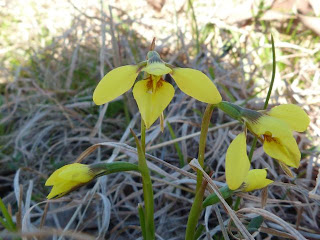Golden moths, peas and other delights
This is a report on the ANPS Wednesday Walk on 7 September 2011 to the NW section of the Mulligans Flat element of Canberra Nature Park. That is a lot of detail to describe a very interesting area.
I will give pride of place to the Golden Moth Orchids (Diuris chryseopsis) since they are the first native orchids we have encountered this year. After finding an isolated plant they turned up in swathes. Here is part of a swathe!
Being a total fiend for following the subject line of these posts let us move to "peas". That is the name colloquially used for members of the family Fabaceae (which means Beans - go figure). They are usually species which flower in Spring/Summer so are just starting to hit their straps.
To begin with Dillwynia sericea ..
... moving right along to Pultenaea microphylla initially seen as an isolated flower but more floribundous in a more sheltered area ...
and concluding with that old favourite Bossiaea buxifolia.
There were of course some white flowers and this week, to quote Flacco, I choose to show Cryptandra amara longiflora.
Also in the 'white area' but taking a swing back toward monocotyledons we have the first Early Nancies I have seen this year.
In case anyone wonders why Exocarpus cupressiformes is called "Native cherry" or "Cherry Ballart" wonder no more. Tell me that doesn't look like a cherry!
The most interesting tree I saw today was in fact an ex-tree. When it passed from the vertical to the horizontal it took several parts of the local geology with it!
Getting back down the botanical tree from Angiosperms we come across some attractive lichen
and a rather lurid, but very small (thank you Frances for finding it) fungus (which I suspect may be something in the Hygrocybe genus.
I had no luck photographing birds but got a couple of reasonable image of invertebrates. Thanks to Roger Farrow for the IDs.
First up a Centipede (Scolopendra sp.)
and a scorpion Cercophonius squama (thanks for finding it Jen - and Peter, I still marvel at your skill at manipulating this chap).
Peter thought it was a gravid female (so I guess he was manipulating a chapess).
I will give pride of place to the Golden Moth Orchids (Diuris chryseopsis) since they are the first native orchids we have encountered this year. After finding an isolated plant they turned up in swathes. Here is part of a swathe!
Being a total fiend for following the subject line of these posts let us move to "peas". That is the name colloquially used for members of the family Fabaceae (which means Beans - go figure). They are usually species which flower in Spring/Summer so are just starting to hit their straps.
To begin with Dillwynia sericea ..
... moving right along to Pultenaea microphylla initially seen as an isolated flower but more floribundous in a more sheltered area ...
and concluding with that old favourite Bossiaea buxifolia.
There were of course some white flowers and this week, to quote Flacco, I choose to show Cryptandra amara longiflora.
Also in the 'white area' but taking a swing back toward monocotyledons we have the first Early Nancies I have seen this year.
In case anyone wonders why Exocarpus cupressiformes is called "Native cherry" or "Cherry Ballart" wonder no more. Tell me that doesn't look like a cherry!
The most interesting tree I saw today was in fact an ex-tree. When it passed from the vertical to the horizontal it took several parts of the local geology with it!
Getting back down the botanical tree from Angiosperms we come across some attractive lichen
and a rather lurid, but very small (thank you Frances for finding it) fungus (which I suspect may be something in the Hygrocybe genus.
I had no luck photographing birds but got a couple of reasonable image of invertebrates. Thanks to Roger Farrow for the IDs.
First up a Centipede (Scolopendra sp.)
and a scorpion Cercophonius squama (thanks for finding it Jen - and Peter, I still marvel at your skill at manipulating this chap).
Peter thought it was a gravid female (so I guess he was manipulating a chapess).















Comments
.
I am astounded (and jealous) that you have D. chryseopsis so early. I shall have to rush out tomorrow and check likely spots around here. But no Donkeys of any species seen in heath land at Kurnell or at the Royal NP yesterday.
I have seen D. maculata at Thirlmere Lakes and Nowra. Both sites much lower and warmer than here - or Mulligans Flat for that matter.
Really nice Centipede and Scorpion.
Cheers
Denis